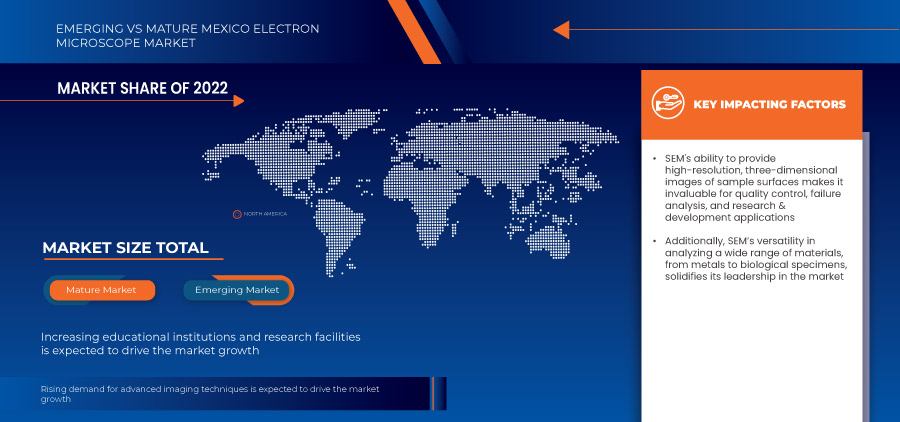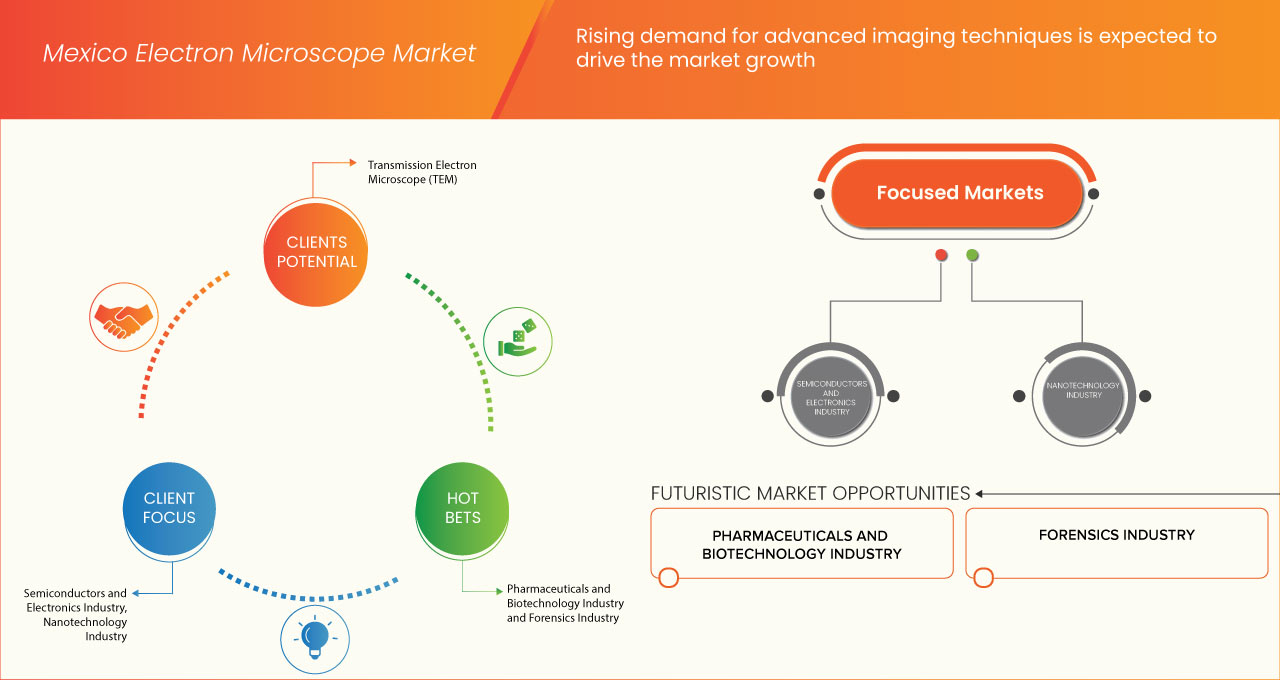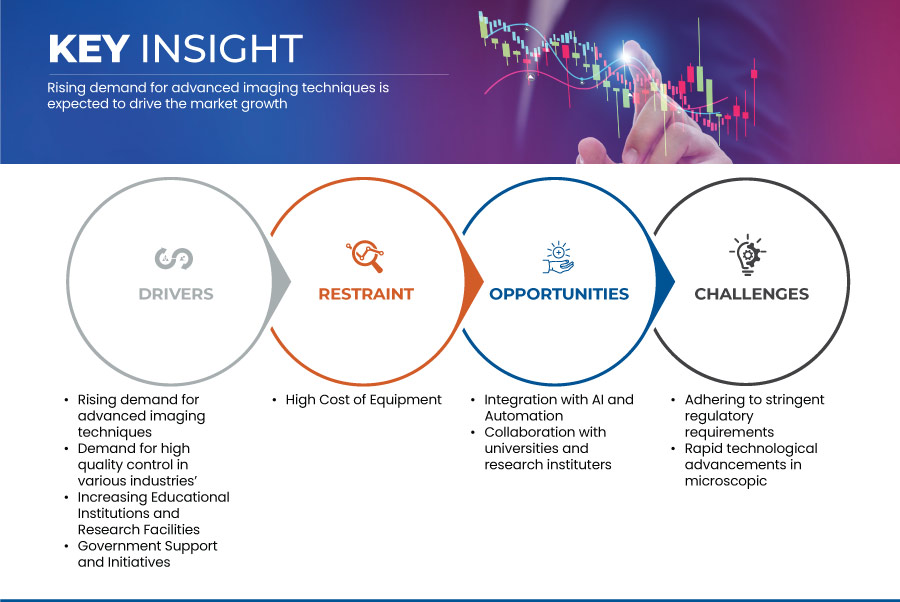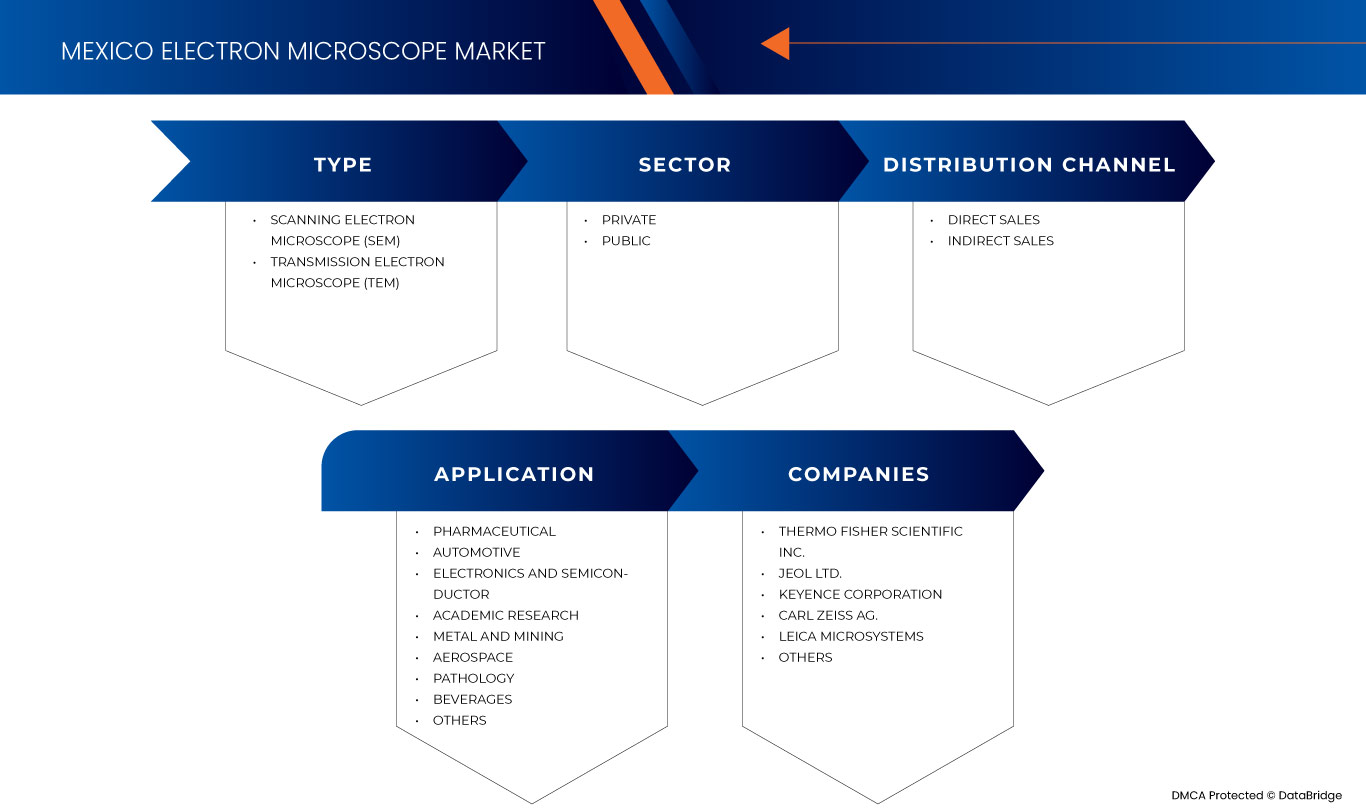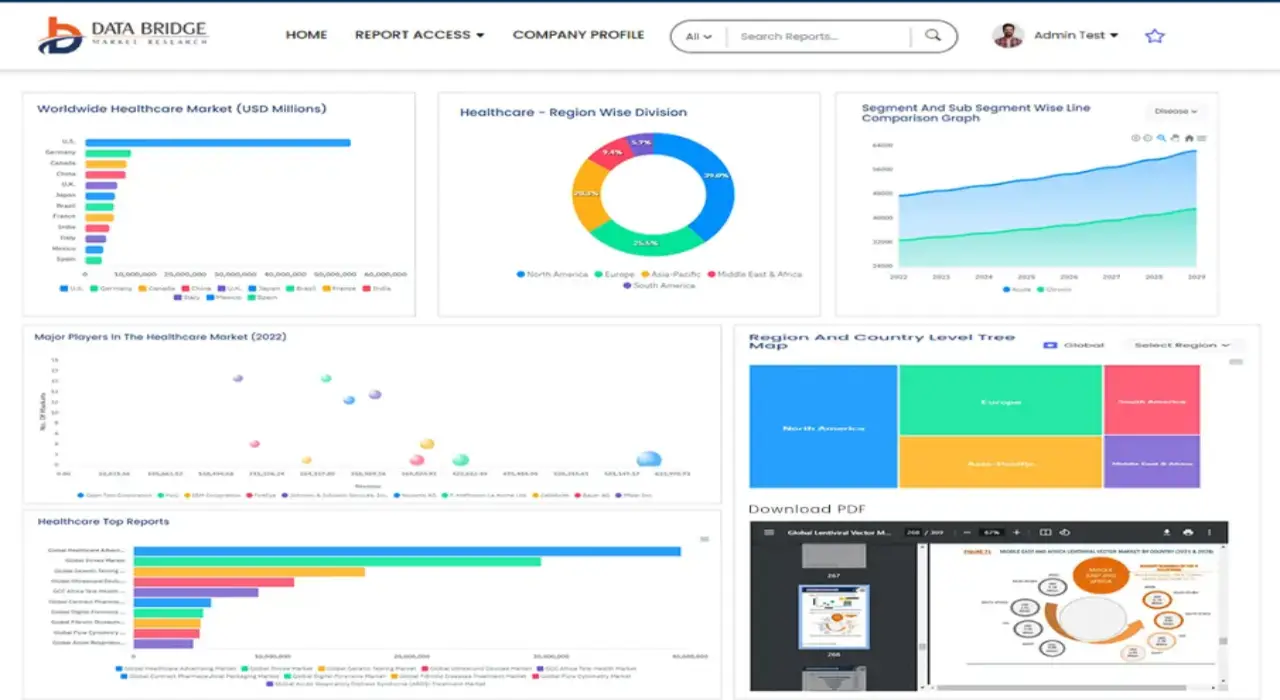Mexico Electron Microscope Market
Marktgröße in Milliarden USD
CAGR :
% 
 USD
278.99 Million
USD
568.83 Million
2024
2032
USD
278.99 Million
USD
568.83 Million
2024
2032
| 2025 –2032 | |
| USD 278.99 Million | |
| USD 568.83 Million | |
|
|
|
Mexico Electron Microscope Market Segmentation, By Type (Scanning Electron Microscope (SEM) and Transmission Electron Microscope (TEM), Sector (Private and Public), Distribution Channel (Direct Sales and Indirect Sales), Application (Pharmaceutical, Automotive, Electronics and Semiconductor, Academic Research, Metal and Mining, Aerospace, Pathology, Beverages, and Others) – Industry Trends and Forecast to 2031.
Electron Microscope Market Analysis
The Mexico electron microscope market is poised for significant growth, driven by advancements in imaging technology and increasing applications across various sectors, including materials science, biotechnology, and nanotechnology. As industries seek higher precision and resolution in their research and development processes, the demand for advanced electron microscopes, such as scanning electron microscopes (SEM) and transmission electron microscopes (TEM), has surged. Furthermore, the rising focus on Semiconductor manufacturing and nanomaterials has intensified the need for sophisticated characterization tools. However, challenges such as stringent regulatory requirements, high costs of equipment, and the necessity for skilled personnel may impact market growth.
Electron Microscope Market Size
Data Bridge Market Research Analyses that Mexico electron microscope market size was valued at USD 256.54 million in 2023 and is projected to reach USD 520.37 million by 2031, growing with a CAGR of 9.3% during the forecast period of 2024 to 2031. In addition to the insights on market scenarios such as market value, growth rate, segmentation, geographical coverage, and major players, the market reports curated by the Data Bridge Market Research also include depth expert analysis, patient epidemiology, pipeline analysis, pricing analysis, and regulatory framework.
Electron Microscope Market Trends
“Government Support and Initiatives”
Government support and initiatives play a critical role in the growth of the electron microscope market in Mexico. Investments in scientific research, education, and technological advancements encourage the adoption of high-end equipment like electron microscopes in both public and private research institutions. Additionally, Mexico's free trade agreements, particularly those involving medical equipment and instruments, facilitate easier importation of advanced electron microscopes at lower costs. This fosters an environment where institutions can access cutting-edge technologies, further driving innovation and research development across various sectors.
The strategic support and initiatives from the Mexican government are set to enhance the electron microscope market by creating a favourable environment for research and development. With free trade agreements like the USMCA, local manufacturers will benefit from improved access to high-quality components and technology. This can lead to increased investment in advanced medical and research equipment, including electron microscopes, facilitating innovation and improving healthcare outcomes. Additionally, the government's commitment to enhancing healthcare infrastructure will likely boost the demand for sophisticated imaging technologies, positioning Mexico as a competitive player in the electron microscope market.
Report Scope and Electron Microscope Market Segmentation
|
Attributes |
Electron Microscope Key Market Insights |
|
Segments Covered |
By Application: Pharmaceutical, Automotive, Electronics and Semiconductor, Academic Research, Metal and Mining, Aerospace, Pathology, Beverages, and Others |
|
Countries Covered |
Mexico |
|
Key Market Players |
EOL Ltd. (Japan), Thermo Fisher Scientific Inc. (U.S.), Carl Zeiss AG. (Germany), Hitachi, Ltd. (Japan), Delong America Inc. (Czech Republic), Bruker (U.S.), KEYENCE CORPORATION (Japan), ELECTRON OPTICS INSTRUMENTS(U.S.), TESCAN GROUP, a.s. (Czech Republic), Leica Microsystems (Germany) |
|
Market Opportunities |
|
|
Value Added Data Infosets |
In addition to the insights on market scenarios such as market value, growth rate, segmentation, geographical coverage, and major players, the market reports curated by the Data Bridge Market Research also include depth expert analysis, patient epidemiology, pipeline analysis, pricing analysis, and regulatory framework. |
Electron Microscope Market Definition
The electron microscope market refers to the sector encompassing the development, manufacturing, distribution, and application of electron microscopes, which are advanced imaging tools that use electron beams to achieve high-resolution images of materials at the microscopic level. This market includes various types of electron microscopes, such as scanning electron microscopes (SEM), transmission electron microscopes (TEM), and cryogenic electron microscopes (cryo-EM), utilized across multiple industries, including materials science, biology, nanotechnology, and Semiconductor manufacturing. The market is driven by the increasing demand for high-resolution imaging and characterization techniques in research and industrial applications, along with advancements in electron microscopy technology.
Electron Microscope Market Dynamics
Drivers
- Rising Demand For Advanced Imaging Techniques
The rising demand for advanced imaging techniques is significantly driving the growth of the electron microscope market. As industries such as materials science, nanotechnology, and pharmaceuticals increasingly require high-resolution imaging for detailed analysis at the nanoscale, electron microscopes have become essential tools. Their ability to provide superior resolution compared to traditional optical microscopes enables researchers and manufacturers to examine materials and biological specimens with unprecedented detail, facilitating advancements in product development, quality control, and fundamental scientific research. This trend underscores the critical role of electron microscopy in meeting the evolving needs of various sectors seeking precision and accuracy in their imaging capabilities.
For instance,
- In May 2024, JEOL released the JEM-120i electron microscope, designed to be compact, easy to use, and expandable for various applications in biotechnology, nanotechnology, and advanced materials. The JEM-120i featured a footprint reduced by over 50%, allowing for efficient space utilization, and an automated control system that simplified operation for both beginners and experienced users. It offered resolutions of 0.2 nm (HC) and 0.14 nm (HR), with a magnification range of 50 to 1,500,000. The microscope could be enhanced with additional functionalities, such as STEM and EDS. This innovation positioned JEOL to better meet the growing demand for advanced imaging techniques, improving accessibility and efficiency in research and testing environments
Demand for High Quality Control in Various Industries
The demand for high-quality control in various industries is increasingly influencing the adoption of electron microscopes, as these advanced tools provide unparalleled imaging resolution and analytical capabilities. Industries such as Semiconductor manufacturing, pharmaceuticals, and materials science require precise characterization of materials to ensure product quality and reliability. Electron microscopes enable thorough inspection and analysis of microstructures, allowing companies to identify defects, optimize processes, and comply with stringent quality standards. As businesses prioritize quality assurance to maintain competitive advantage, the integration of electron microscopy into quality control protocols is becoming essential for achieving consistent and reliable results across various applications
For instance,
- In December 2023, Hitachi High-Tech launched the GT2000 high-precision electron beam metrology system to enhance Semiconductor device development and mass production, particularly for High-NA EUV processes. The GT2000, leveraging Hitachi High-Tech's expertise in CD-SEM technology, features low-damage, high-speed multi-point measurement capabilities to minimize resist damage and improve production yields. It also incorporates a high-sensitivity detection system for complex 3D device structures and redesigned optical systems to enhance tool-to-tool measurement consistency. This innovation positioned Hitachi High-Tech to better meet customer needs in Semiconductor manufacturing, ultimately contributing to increased efficiency and quality in the industry
Opportunities
- Integration with Ai and Automation
Integration with AI and automation presents a valuable opportunity for the electron microscope market in Mexico. By incorporating advanced AI algorithms and automated processes, electron microscopes can enhance imaging capabilities, streamline data analysis, and improve overall operational efficiency. This technological synergy can lead to more accurate and faster results in various applications, such as materials science, biotechnology, and Semiconductor research. Furthermore, the adoption of AI-driven solutions can attract investment and foster innovation within the sector, ultimately positioning Mexico as a leader in high-tech research and development.
For instance,
- In August 2022 according to the blog published by the ZEISS, researchers from arivis AG developed a scalable and automated AI image analysis workflow for volume electron microscopy, focusing on FIB-SEM images of HeLa cells. They utilized the ZEISS arivis Cloud platform to train neural networks that accurately identified cellular structures, such as mitochondria and nuclei, within 3D image volumes. This automated approach improved the efficiency of data analysis, enabling quicker and more precise quantification of cellular features. By integrating AI and automation, ZEISS enhanced its capabilities in electron microscopy, offering significant benefits in research productivity and data accuracy for users in various scientific fields
Collaboration with Universities and Research Instituters
Collaboration with universities and research institutions is essential for advancing the capabilities of electron microscopy in Mexico. These partnerships can facilitate knowledge exchange, drive innovation, and enhance training programs, ensuring that researchers are equipped with the latest skills and technologies. By working together, academic and research entities can leverage shared resources, access cutting-edge equipment, and promote interdisciplinary studies that deepen understanding in various scientific fields. Such collaborations not only accelerate research outcomes but also strengthen the overall scientific community in Mexico, fostering an environment conducive to breakthroughs in materials science, nanotechnology, and biomedical research.
For instance,
- In July 2024, according to the article published by Cision US Inc., Danaher Corporation announced a research collaboration with Stanford University’s Department of Bioengineering to develop advanced "smart microscopy" for cancer drug screening. The initiative aimed to combine spatial biology and AI to better understand tumor microenvironments and reduce clinical trial failure rates. By leveraging this partnership, Danaher sought to enhance its technological capabilities in microscopy, improve drug screening processes, and ultimately contribute to the development of more effective cancer treatments
Restraints/Challenges
- High Cost of Equipment
The high cost of electron microscopes presents a significant restraint for the market in Mexico, limiting accessibility for many educational institutions and research facilities. The substantial initial investment required for purchasing, installing, and maintaining these advanced instruments can deter smaller organizations from acquiring them, thereby hindering research capabilities and innovation. This financial barrier is particularly pronounced in a country where budget constraints often impact public sector spending on scientific equipment, further restricting the growth and adoption of electron microscopy technology in various fields.
For instance,
- In September 2019, according to the blog published by NAPS, the General Directorate of Standards (DGN) in Mexico updated various compliance regulations for manufacturing, including the Official Mexican Standards (NOMs) and Mexican Standards (NMXs). These standards mandated that electronic equipment, such as electron microscopes, meet strict safety and performance requirements. While companies that complied could enhance operational reliability and gain consumer trust, the continuous need for adherence to these regulations imposed significant pressure on manufacturers. This ongoing commitment to regulatory compliance could divert critical resources away from innovation, making it increasingly difficult for companies to navigate the complexities of the market
Adhering to Stringent Regulatory Requirements
Adhering to stringent regulatory requirements poses a significant challenge for the electron microscope market, particularly in sectors like medical instruments and equipment manufacturing. Regulatory bodies demand high standards of precision, safety, and compliance in imaging technologies used for medical diagnostics and research. Meeting these rigorous guidelines often requires costly and time-consuming certifications, which can slow down the development and deployment of new electron microscope models. Additionally, ensuring ongoing compliance with evolving regulations adds complexity for manufacturers, particularly when introducing innovations in highly sensitive medical environments
For instance,
- In June 2023, according to a blog published by EMERGO by UL, Mexico’s Ministry of Health updated its medical device registration requirements through the 5.0 edition of the Supplement of Medical Devices in the Mexican Pharmacopoeia. Key updates included new definitions for manufacturers, intended use, and clinical evaluation, aligning with EU MDR standards. Electron microscope manufacturers must now provide detailed technical and scientific information, such as manufacturing flowcharts and sterilization reports, to ensure compliance. These regulations enhance product traceability and quality control, benefiting companies by streamlining market access while ensuring adherence to standards
This market report provides details of new recent developments, trade regulations, import-export analysis, production analysis, value chain optimization, market share, impact of domestic and localized market players, analyses opportunities in terms of emerging revenue pockets, changes in market regulations, strategic market growth analysis, market size, category market growths, application niches and dominance, product approvals, product launches, geographic expansions, technological innovations in the market. To gain more info on the market contact Data Bridge Market Research for an Analyst Brief, our team will help you take an informed market decision to achieve market growth.
Electron Microscope Market Scope
Der Markt ist nach Typ, Sektor, Vertriebskanal und Anwendung segmentiert. Das Wachstum dieser Segmente hilft Ihnen bei der Analyse schwacher Wachstumssegmente in den Branchen und bietet den Benutzern einen wertvollen Marktüberblick und Markteinblicke, die ihnen bei der strategischen Entscheidungsfindung zur Identifizierung der wichtigsten Marktanwendungen helfen.
Nach Typ
- Rasterelektronenmikroskop (REM)
- Modalität
- Tischgerät
- Tragbar
- Auflösung
- Weniger als ein Nanometer
- Zwei Nanometer
- Drei Nanometer
- Sonstiges
- Komponente
- Elektronenquelle
- Typ
- Dual Beam oder FIB-SEM
- Wolframfilament
- Feldemissionskanone (FEG)
- Objektive
- Detektoren
- Abtastspule
- Sonstiges
- Technologie
- Sekundärelektronendetektor (SE)
- Elektronenrückstreubeugung
- Kathodolumineszenz
- Elektronenstrahlinduzierter Strom
- Sonstiges
- Modalität
- Transmissionselektronenmikroskop (TEM)
- Modalität
- Tischgerät
- Tragbar
- Typ
- Kryo-Tem
- Sonstiges
- Komponente
- Vakuumsystem
- Detektoren
- Typ
- Bildkameras
- Spektrometer
- Sonstiges
- Elektronenkanone
- Elektronenlinsen
- Sonstiges
- Modalität
- Auflösung
- Weniger als ein Nanometer
- Über 1 Nanometer
- Stromspannung
- 200 KV
- 120 KV
- Sonstiges
Nach Sektor
- Privat
- Öffentlich
Nach Vertriebskanal
- Direktvertrieb
- Typ
- Zur Firma
- E-Einkauf
- Typ
- Indirekter Vertrieb
- Typ
- Großhändler & Distributor
- Sonstiges
- Typ
Nach Anwendung
- Pharmazeutische
- Typ
- Rasterelektronenmikroskop (REM)
- Modalität
- Tischgerät
- Tragbar
- Produkttyp
- Dual Beam oder FIB-SEM
- Wolfram
- Feldemissionskanone (FEG)
- Transmissionselektronenmikroskop (TEM)
- Modalität
- Tischgerät
- Tragbar
- Typ
- Kryo-Tem
- Sonstiges
- Stromspannung
- TEM (200 KV)
- TEM (120 KV)
- Sonstiges
- Typ
- Anwendung
- Arzneimittelempfindlichkeitstest
- Arzneimittelverabreichung
- Metallidentifizierung in Arzneimitteln
- Visualisierung organischer und anorganischer Partikel
- Abgrenzung
- Sonstiges
- Automobilindustrie
- Fahrzeugtyp
- Konventionell/Eis
- EV
- Hybrid
- Typ
- Rasterelektronenmikroskop (REM)
- Modalität
- Tischgerät
- Tragbar
- Produkttyp
- Dual Beam oder FIB-SEM
- Wolfram
- Feldemissionskanone (FEG)
- Transmissionselektronenmikroskop (TEM)
- Modalität
- Tischgerät
- Tragbar
- Typ
- Kryo-Tem
- Sonstiges
- Stromspannung
- TEM (200 KV)
- TEM (120 KV)
- Sonstiges
- Fahrzeugtyp
- Elektronik und Halbleiter
- Typ
- Rasterelektronenmikroskop (REM)
- Modalität
- Tischgerät
- Tragbar
- Produkttyp
- Dual Beam oder Fib-Sem
- Wolfram
- Feldemissionskanone (FEG)
- Transmissionselektronenmikroskop (TEM)
- Modalität
- Tischgerät
- Tragbar
- Typ
- Kryo-TEM
- Sonstiges
- Stromspannung
- TEM (200 KV)
- TEM (120 KV)
- Sonstiges
- Typ
- Anwendung
- Fehleranalyse integrierter Schaltkreise
- Prüfung von Drahtverbindungen
- Verpackung
- Sonstiges
- Akademische Forschung
- Typ
- Rasterelektronenmikroskop (REM)
- Modalität
- Tischgerät
- Tragbar
- Produkttyp
- Dual Beam oder Fib-SEM
- Wolfram
- Feldemissionskanone (FEG)
- Transmissionselektronenmikroskop (TEM)
- Modalität
- Tischgerät
- Tragbar
- Typ
- Kryo-Tem
- Sonstiges
- Stromspannung
- TEM (200 KV)
- TEM (120 KV)
- Sonstiges
- Typ
- Metall und Bergbau
- Typ
- Rasterelektronenmikroskop (REM)
- Modalität
- Tischgerät
- Tragbar
- Produkttyp
- Dual Beam oder FIB-SEM
- Wolfram
- Feldemissionskanone (FEG)
- Transmissionselektronenmikroskop (TEM)
- Modalität
- Tischgerät
- Tragbar
- Typ
- Kryo-Tem
- Sonstiges
- Stromspannung
- TEM (200 KV)
- TEM (120 KV)
- Sonstiges
- Typ
- Luft- und Raumfahrt
- Typ
- Rasterelektronenmikroskop (REM)
- Modalität
- Tischgerät
- Tragbar
- Produkttyp
- Dual Beam oder FIB-SEM
- Wolfram
- FELD-Emissionskanone (Feg)
- Transmissionselektronenmikroskop (TEM)
- Modalität
- Tischgerät
- Tragbar
- Typ
- Kryo-Tem
- Sonstiges
- Stromspannung
- TEM (200 KV)
- TEM (120 KV)
- Sonstiges
- Typ
- Pathologie
- Typ
- Rasterelektronenmikroskop (REM)
- Modalität
- Tischgerät
- Tragbar
- Produkttyp
- Dual Beam oder FIB-SEM
- Wolfram
- Feldemissionskanone (FEG)
- Transmissionselektronenmikroskop (TEM)
- Modalität
- Tischgerät
- Tragbar
- Typ
- Kryo-TEM
- Sonstiges
- Stromspannung
- TEM (200 KV)
- TEM (120 KV)
- Sonstiges
- Typ
- Getränke
- Typ
- Rasterelektronenmikroskop (REM)
- Modalität
- Tischgerät
- Tragbar
- Produkttyp
- Dual Beam oder FIB-SEM
- Wolfram
- Feldemissionskanone (FEG)
- Transmissionselektronenmikroskop (TEM)
- MODALITÄT
- Tischgerät
- Tragbar
- TYP
- Kryo-Tem
- Sonstiges
- Stromspannung
- TEM (200 KV)
- TEM (120 KV)
- Sonstiges
- Typ
- Sonstiges
- Typ
- Rasterelektronenmikroskop (REM)
- Modalität
- Tischgerät
- Tragbar
- Produkttyp
- Dual Beam oder FIB-SEM
- Wolfram
- Feldemissionskanone (FEG)
- Transmissionselektronenmikroskop (TEM)
- Modalität
- Tischgerät
- Tragbar
- TYP
- Kryo-Tem
- Sonstiges
- Stromspannung
- TEM (200 KV)
- TEM (120 KV)
- Sonstiges
- Typ
Marktanteil von Elektronenmikroskopen
Die Wettbewerbslandschaft des Marktes liefert Details nach Wettbewerbern. Die enthaltenen Details sind Unternehmensübersicht, Unternehmensfinanzen, erzielter Umsatz, Marktpotenzial, Investitionen in Forschung und Entwicklung, neue Marktinitiativen, Produktionsstandorte und -anlagen, Produktionskapazitäten, Stärken und Schwächen des Unternehmens, Produkteinführung, Produktbreite und -umfang, Anwendungsdominanz. Die oben angegebenen Datenpunkte beziehen sich nur auf den Fokus der Unternehmen in Bezug auf den Markt.
Die auf dem Markt tätigen Marktführer für Elektronenmikroskope sind:
- (Japan)
- Thermo Fisher Scientific Inc. (USA)
- Carl Zeiss AG. (Deutschland)
- (Japan)
- Delong America Inc. (Tschechische Republik)
- Bruker (USA)
- KEYENCE CORPORATION (Japan)
- ELEKTRONOPTIK-INSTRUMENTE (USA)
- TESCAN GROUP, as (Tschechische Republik)
- Leica Microsystems (Deutschland)
Neueste Entwicklungen auf dem mexikanischen Elektronenmikroskopmarkt
- Im August erhielt Thermo Fisher Scientific drei R&D 100 Awards, darunter einen Gold Award für das Orbitrap Astral Mass Spectrometer, einen bedeutenden Fortschritt in der Massenspektrometrie. Dieses Instrument verbessert die Proteomabdeckung und den Durchsatz und ermöglicht Durchbrüche in der Präzisionsmedizin. Die Gibco CTS Detachable Dynabeads-Plattform erhielt ebenfalls Anerkennung für ihren innovativen aktiven Freisetzungsmechanismus, der die Effizienz bei der Herstellung von Zelltherapien steigert. Diese Auszeichnungen unterstreichen Thermo Fishers Engagement für wissenschaftliche Innovation
- Im Juli 2024 hat JEOL Ltd. am 28. Juli 2024 das neue Schottky-Feldemissions-Rasterelektronenmikroskop JSM-IT810 auf den Markt gebracht. Dieses Modell verfügt über eine verbesserte Automatisierung, einschließlich der Funktion „Neo Action“ zur automatischen Beobachtung und Analyse sowie eines automatischen Kalibrierungspakets. Mit integrierten EDS-Funktionen und Echtzeit-3D-Bildgebung verbessert das JSM-IT810 die Effizienz und Genauigkeit in verschiedenen wissenschaftlichen Anwendungen
- Im Juni führte Keyence das digitale Mikroskop VHX-7000N im Reinraum von Evansdale ein. Es bietet Vergrößerungen von 20x bis 2500x und eine 12-Megapixel-Kamera für detaillierte Inspektionen ohne Objektivwechsel. Das VHX-7000N kombinierte die Funktionen eines Stereomikroskops, eines Metallurgiemikroskops, eines zusammengesetzten Mikroskops, eines Rasterelektronenmikroskops und eines Messmikroskops und lieferte hochauflösende Bilder auf einem 4K-Monitor. Diese Entwicklung kam Keyence zugute, da sie seine Position auf dem Markt für Elektronenmikroskope mit einer vielseitigen, leistungsstarken Alternative stärkte, die die Bildgebungs- und Messaufgaben für Forscher vereinfachte.
SKU-
Erhalten Sie Online-Zugriff auf den Bericht zur weltweit ersten Market Intelligence Cloud
- Interaktives Datenanalyse-Dashboard
- Unternehmensanalyse-Dashboard für Chancen mit hohem Wachstumspotenzial
- Zugriff für Research-Analysten für Anpassungen und Abfragen
- Konkurrenzanalyse mit interaktivem Dashboard
- Aktuelle Nachrichten, Updates und Trendanalyse
- Nutzen Sie die Leistungsfähigkeit der Benchmark-Analyse für eine umfassende Konkurrenzverfolgung
Forschungsmethodik
Die Datenerfassung und Basisjahresanalyse werden mithilfe von Datenerfassungsmodulen mit großen Stichprobengrößen durchgeführt. Die Phase umfasst das Erhalten von Marktinformationen oder verwandten Daten aus verschiedenen Quellen und Strategien. Sie umfasst die Prüfung und Planung aller aus der Vergangenheit im Voraus erfassten Daten. Sie umfasst auch die Prüfung von Informationsinkonsistenzen, die in verschiedenen Informationsquellen auftreten. Die Marktdaten werden mithilfe von marktstatistischen und kohärenten Modellen analysiert und geschätzt. Darüber hinaus sind Marktanteilsanalyse und Schlüsseltrendanalyse die wichtigsten Erfolgsfaktoren im Marktbericht. Um mehr zu erfahren, fordern Sie bitte einen Analystenanruf an oder geben Sie Ihre Anfrage ein.
Die wichtigste Forschungsmethodik, die vom DBMR-Forschungsteam verwendet wird, ist die Datentriangulation, die Data Mining, die Analyse der Auswirkungen von Datenvariablen auf den Markt und die primäre (Branchenexperten-)Validierung umfasst. Zu den Datenmodellen gehören ein Lieferantenpositionierungsraster, eine Marktzeitlinienanalyse, ein Marktüberblick und -leitfaden, ein Firmenpositionierungsraster, eine Patentanalyse, eine Preisanalyse, eine Firmenmarktanteilsanalyse, Messstandards, eine globale versus eine regionale und Lieferantenanteilsanalyse. Um mehr über die Forschungsmethodik zu erfahren, senden Sie eine Anfrage an unsere Branchenexperten.
Anpassung möglich
Data Bridge Market Research ist ein führendes Unternehmen in der fortgeschrittenen formativen Forschung. Wir sind stolz darauf, unseren bestehenden und neuen Kunden Daten und Analysen zu bieten, die zu ihren Zielen passen. Der Bericht kann angepasst werden, um Preistrendanalysen von Zielmarken, Marktverständnis für zusätzliche Länder (fordern Sie die Länderliste an), Daten zu klinischen Studienergebnissen, Literaturübersicht, Analysen des Marktes für aufgearbeitete Produkte und Produktbasis einzuschließen. Marktanalysen von Zielkonkurrenten können von technologiebasierten Analysen bis hin zu Marktportfoliostrategien analysiert werden. Wir können so viele Wettbewerber hinzufügen, wie Sie Daten in dem von Ihnen gewünschten Format und Datenstil benötigen. Unser Analystenteam kann Ihnen auch Daten in groben Excel-Rohdateien und Pivot-Tabellen (Fact Book) bereitstellen oder Sie bei der Erstellung von Präsentationen aus den im Bericht verfügbaren Datensätzen unterstützen.

